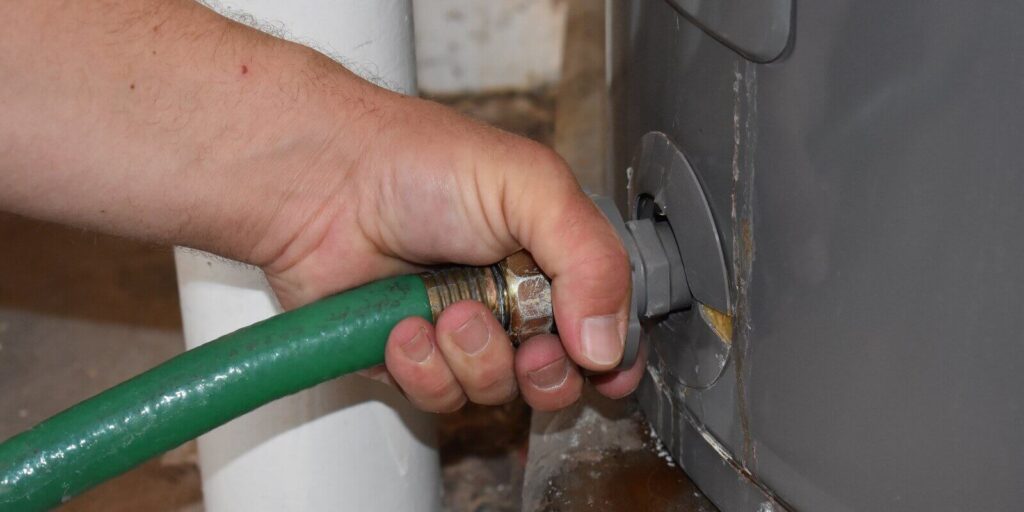
Everyone appreciates a warm shower after a long day, but sometimes your water heater has other ideas. One of the most important things you can do to ensure that your water heater continues to operate optimally is regularly flushing your tank.
This allows you to remove the buildup of dirt and sediment that naturally accumulates within the bottom of the tank over time.
This accumulation is considered relatively normal as most public water supplies contain a certain concentration of minerals, such as magnesium and calcium, as well as trace amounts of dirt that tend to sink to the bottom of your water heater tank, where they can build up to form a substantial layer with time.
Unfortunately, this built-up layer of sediment effectively serves as an insulator for a gas water heater, stopping it from heating water as efficiently as it once did. Moreover, the additional stress that this places on tanks can cause your water heater to wear out faster and require an expensive replacement sooner than expected.
Flushing your water heater allows you to remove this layer of sediment so that it can continue to operate smoothly. However, it is important to understand the difference between flushing your water heater and draining it.
Many homeowners confuse these two processes, but keep in mind that draining your heater will not remove the built-up sediment that can compromise the functioning of your hot water heater.

The Water Supply Makes All The Difference
The main difference between flushing your water heater and simply draining it relates to the status of your water supply. If you turn your water supply off before you begin the process, you are merely draining it, and this only serves to empty the tank.
However, if you keep the water supply on throughout the process, you will be flushing out the sediment. This means that all of the water within the tank will be replaced with new water. The constant flow of water plays a crucial role in washing away the sediment that has built up inside your tank.
You should make a point of flushing and draining your water heater from time to time in order to assess the health of your tank and the condition of the water your home is using.
How To Flush Your Water Heater Tank
It is recommended that homeowners flush their water heater at least one time per year to remove accumulated buildup. Thankfully, it is a very simple process to carry out.
First, you should shut off your heat and then connect a hose to the tank drain valve and open it up. Allow the tank to drain for a few minutes, taking regular samples throughout the process by emptying some water from the hose out into a bucket. If you notice any sediment in the water, you should continue flushing it until your samples start coming out clean.
When you consistently get clean samples, it is time to shut off the drain valve and let the tank refill. Then, turn the heat back on and allow the tank to come back up to temperature.
How To Drain Your Water Heater Tank
It is also recommended that homeowners drain their water heater tank once per year. To do this, first you will need to shut off the water supply and then place a large bucket under the water heater’s drain valve. As it drains, you will want to empty it bucket by bucket. This process may take some time.
As you get toward the last few buckets, it is time to start paying attention to the condition of the water that comes out of the tank. If you notice a rust color or an unusual smell, this could be a sign that the tank may soon start to leak. It is a good idea to call a plumber to take a closer look and determine how the water heater’s life can be prolonged.

How To Check The Shut-Off Valve
Both draining and flushing your tank give you the opportunity to check your shut-off valve to ensure that it still works. These valves are placed on water heater tanks to allow the water heater to be turned off in an emergency.
However, if they are not used or moved for several years, they may fail. You can test this when your tank is empty by opening the temperature and pressure relief valve, which is usually situated at the top of the tank. All you need to do is open and close this valve several times to ensure it moves smoothly.
Reach Out To Baumbach Plumbing And Remodeling
If you are experiencing any problems with your water heater or your home’s hot water supply or you would like to have a professional flush or drain your water tank, get in touch with the friendly residential plumbers at Baumbach Plumbing And Remodeling.
Our team of licensed, insured and bonded plumbers are on hand to address all of your plumbing needs in the Northern Virginia area.






